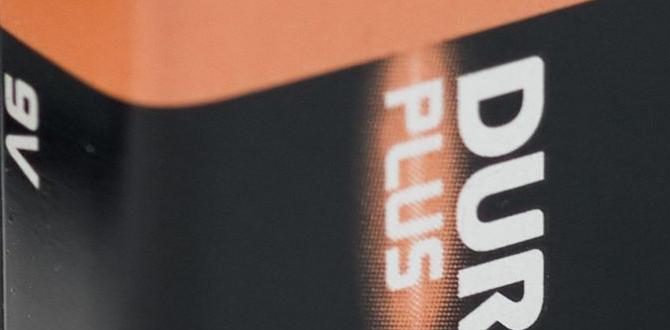For your 2014 Chevy Cruze, the most common battery size you’ll need is the Group Size 96R. This size offers a good balance of power and fit for your vehicle’s electrical needs. Always double-check your owner’s manual or a compatibility guide for the most accurate information.
Is your 2014 Chevy Cruze acting sluggish, especially on cold mornings? A weak battery can be the culprit, leaving you frustrated and potentially stranded. Figuring out the right battery size can seem like a puzzle, but it doesn’t have to be. This guide is here to simplify things, making sure you find the perfect fit for your Cruze without any guesswork. We’ll walk you through everything you need to know, from common battery sizes to how to check for yourself.
Understanding Your 2014 Chevy Cruze Battery Needs
Your car’s battery is like its powerhouse. It starts the engine and keeps all the electrical components running when the engine isn’t on. For a compact car like the 2014 Chevy Cruze, you need a battery that’s strong enough but also fits neatly into its designated spot under the hood. Getting the right size is crucial for proper installation and reliable performance.
Several factors determine the battery size: physical dimensions, terminal placement, and cold-cranking amperage (CCA). CCA is especially important in colder climates, as it indicates how much power the battery can deliver to start your engine in freezing temperatures. While your Cruze might have some flexibility, sticking to the recommended size is generally the safest bet for optimal function and longevity of your electrical system.
The Most Common Battery Size for the 2014 Chevy Cruze
After thorough research and consulting common automotive repair resources, the most frequently recommended battery size for the 2014 Chevy Cruze is the Group Size 96R. This size is designed to fit the battery tray and electrical connections specific to this model year. The “R” in 96R indicates that the battery terminals are reversed compared to a standard Group Size 96 battery, which is important for correct cable connections in your Cruze.
When looking for a replacement, you’ll often see “BCI Group Size 96R” on battery labels. This is a standard measurement system used in North America to classify batteries based on their physical dimensions and terminal configuration. Always verifying the group size is an essential step in selecting the correct battery.
What Does “Group Size 96R” Actually Mean?
Let’s break down what “Group Size 96R” means:
- Group Size: This number (96 in this case) refers to a standard set of physical dimensions for the battery case. Batteries within the same group size generally have the same height, width, and length. This ensures they will physically fit into your car’s battery tray.
- “R” for Reversed Terminals: The addition of the “R” is critical. It signifies that the positive and negative battery terminals are in reverse positions compared to a “standard” Group Size 96 battery. Incorrect terminal orientation can prevent the battery cables from reaching, or worse, lead to dangerous short circuits if forced.
Different vehicle manufacturers use various battery group sizes depending on the engine, electrical demands, and available space. For the 2014 Chevy Cruze, the 96R has proven to be the most compatible and widely used size.
Other Potential Battery Sizes and Considerations
While 96R is the standard, it’s always wise to be aware of other possibilities or variations, though they are less common for your specific vehicle. Sometimes, manufacturers might use slightly different battery groups depending on whether the Cruze was equipped with specific premium features or had a different engine option than the most common ones. However, for the vast majority of 2014 Chevy Cruzes, 96R is the go-to.
Here’s why it’s important to check:
- Engine Variations: While less common, some international or specific performance trims might have slightly different requirements.
- Aftermarket Modifications: If your Cruze has had significant electrical upgrades (like a powerful sound system), you might need a battery with higher Cold Cranking Amps (CCA), but typically not a different group size.
Why Sticking to the Recommended Size Matters
Using the correct battery group size ensures several things:
- Proper Fit: The battery will slide securely into its tray.
- Secure Connections: Your car’s battery cables will reach the terminals without strain or the need for modifications.
- Optimal Performance: The battery will perform as designed by the engineers.
- Safety: Prevents the battery from moving around and reduces the risk of electrical shorts.
How to Verify the Correct Battery Size for Your 2014 Chevy Cruze
Even though 96R is the most likely candidate, it’s always best to confirm. Here are a few foolproof ways to make sure you get the right battery:
1. Check Your Owner’s Manual
Your Chevy Cruze’s owner’s manual is the definitive guide for all your vehicle’s specifications. Look in the section related to maintenance or specifications. It will clearly state the recommended battery group size and often the minimum CCA rating.
What to look for: Pages usually dedicated to vehicle specifications, fluid types, or battery maintenance.
2. Inspect Your Current Battery
The easiest way to know what size is currently in your car is to look at the battery itself. Most batteries have their group size clearly printed on a label on the top or side of the case.
Steps:
- Ensure your engine is off and cool.
- Locate the battery under the hood (usually toward the front or side).
- Clean off any dirt or debris from the top or sides of the battery.
- Look for a label that clearly states the “BCI Group Size” (e.g., 96R in large print). You might also see other codes, but the group size is what you’re after.
This is the most direct method, as it tells you exactly what was installed and worked for your vehicle.
3. Use Online Parts Finders
Most reputable auto parts stores have excellent online tools. You can enter your vehicle’s year, make, and model (2014 Chevrolet Cruze) to get a list of compatible batteries.
How it works:
- Visit the website of a major auto parts retailer (e.g., AutoZone, Advance Auto Parts, O’Reilly Auto Parts, NAPA).
- Find their “Find Parts” or “Vehicle Selector” tool.
- Enter “2014” for the year, “Chevrolet” for the make, “Cruze” for the model. You might also need to specify the engine size or trim if prompted.
- The site will then display a list of compatible batteries, their group sizes, CCA ratings, and prices. Look for batteries listed as Group Size 96R.
These tools are generally very accurate, drawing from extensive databases. They are a fantastic resource if you can’t easily access your car or its manual.
4. Consult a Trusted Mechanic
If you’re still unsure or prefer professional help, your local mechanic or a dealership service center can tell you the exact battery size needed for your 2014 Chevy Cruze. They have the expertise and access to vehicle-specific databases.
Key Battery Specifications to Consider Beyond Size
While the group size (96R) is paramount for fit, other specifications ensure your Cruze gets the power it needs to start and run reliably.
Cold Cranking Amps (CCA)
CCA measures a battery’s ability to start an engine in cold weather. It’s the amperage a battery can deliver for 30 seconds at 0°F (-18°C) without dropping below 7.2 volts. For a 2014 Chevy Cruze, a common minimum CCA rating to look for is around 500-600 CCA. If you live in an area with very cold winters, opting for a battery with a higher CCA rating within the appropriate range is a good idea.
Consulting your owner’s manual is the best way to find the manufacturer’s recommended CCA rating. Exceeding it is generally fine, but falling significantly below it might lead to starting issues in cold temperatures.
Reserve Capacity (RC)
Reserve Capacity (RC) indicates how long a fully charged battery can supply 25 amps of power at 80°F (27°C) before its voltage drops below 10.5 volts. This is important if you occasionally find yourself with the engine off but accessories (like the radio or lights) running for extended periods. A higher RC is generally better, with typical values for this car being in the 90-120 minute range.
Battery Type (Flooded, AGM, Gel)
For most standard 2014 Chevy Cruze models, a traditional flooded lead-acid battery is perfectly suitable and the most budget-friendly option. However, if your Cruze came equipped with advanced features like a start-stop system or if you’re looking for enhanced durability and performance, an Absorbent Glass Mat (AGM) battery might be an option. AGM batteries are generally more expensive but offer better performance, longer life, and are spill-proof.
Important Note: If your Cruze originally came with an AGM battery, you must replace it with another AGM battery of the correct size. Modern vehicles with advanced electronics often require AGM batteries for proper function and charging system compatibility. Check your manual or current battery for confirmation.
Comparing Popular Battery Brands and Features
When it comes to replacing your 2014 Chevy Cruze battery, you’ll find many reputable brands. While the Group Size 96R is key, comparing brands based on warranty, price, and customer reviews can help you make an informed decision.
Here’s a look at common considerations when choosing a brand:
- Warranty: Batteries typically come with a free replacement warranty (often 1-3 years) and a pro-rated warranty (for the remaining life of the battery). Longer warranties often indicate higher quality.
- Price: Prices vary significantly. Determine your budget and find the best combination of price and warranty.
- Reputation & Reviews: Brands like Optima, ACDelco (often the original equipment manufacturer for GM vehicles), Bosch, Duralast, and DieHard generally have good reputations for reliability and performance. It’s worth checking recent reviews for specific models.
- CCA Rating: Even within the 96R size, CCA ratings can vary between brands and models.
Typical Battery Specifications Table for 2014 Chevy Cruze (Group Size 96R)
This table provides a general overview of what to expect. Always confirm with your owner’s manual or an online compatibility checker.
| Specification | Typical Value for 2014 Chevy Cruze (96R) | Importance |
|---|---|---|
| BCI Group Size | 96R | Ensures physical fit and terminal orientation. Critical for installation. |
| Cold Cranking Amps (CCA) | 500 – 600+ | Power to start the engine in cold weather. Higher is better in cold climates. |
| Reserve Capacity (RC) | 90 – 120 minutes | Duration the battery can power accessories with the engine off. |
| Voltage | 12 Volts | Standard for automotive vehicles. |
| Terminal Type | Top Post (standard) | Ensures compatibility with your Cruze’s cables. |
Safety First: Handling Your Car Battery
Car batteries contain corrosive acid and can release flammable hydrogen gas. Always follow these safety precautions when handling or replacing a battery:
- Wear Safety Gear: Always wear safety glasses or goggles and chemical-resistant gloves.
- No Sparks: Keep sparks, open flames, and smoking materials away from the battery. Batteries can emit explosive hydrogen gas.
- Good Ventilation: Work in a well-ventilated area.
- Avoid Shorts: Never allow metal tools or jewelry (like necklaces or bracelets) to touch both battery terminals simultaneously, as this can cause a short circuit, sparks, and even an explosion.
- Disconnect Properly: Always disconnect the negative (-) terminal first, followed by the positive (+) terminal. When reconnecting, connect the positive (+) terminal first, then the negative (-).
- Secure Mounting: Ensure the battery is securely fastened in its tray to prevent movement.
- Battery Acid: If you come into contact with battery acid, flush the affected area immediately with plenty of water and seek medical attention if necessary.
For more detailed safety information, you can refer to resources like the U.S. Environmental Protection Agency (EPA) on lead-acid battery recycling and handling.
How to Replace Your 2014 Chevy Cruze Battery (Step-by-Step)
Replacing your battery is a manageable DIY task if you’re comfortable working on your car. Here’s a straightforward guide:
Tools You’ll Need:
- New battery (correct Group Size 96R, appropriate CCA)
- Wrench set (common sizes for battery terminals and hold-down bracket are often 10mm, 13mm, or 1/2 inch)
- Battery terminal cleaner brush or wire brush
- Terminal protector spray or grease
- Gloves and safety glasses
- Optional: Socket wrench with extension, anti-static wrist strap
Step-by-Step Replacement:
- Park and Prepare: Park your Cruze on a level surface, engage the parking brake, and turn off the engine. Open the hood and locate the battery. Let the engine cool down if it’s been recently run.
- Disconnect Negative Terminal: Using the correct size wrench, loosen and remove the nut on the negative (-) terminal clamp. Twist and lift the cable off the terminal. Tuck it aside so it can’t accidentally touch the terminal.
- Disconnect Positive Terminal: Now, loosen and remove the nut on the positive (+) terminal clamp. Twist and lift the cable off the terminal. Keep it separate from the negative cable.
- Remove Battery Hold-Down: Most batteries are held in place by a bracket or clamp at the base. Find the bolt(s) securing this bracket (often at the bottom front of the battery) and remove them using your wrench. Lift the bracket out.
- Remove the Old Battery: Carefully lift the old battery straight up and out of the battery tray. Batteries are heavy, so use proper lifting technique (bend your knees!). Place it on a sturdy surface.
- Clean Battery Tray and Terminals: Inspect the battery tray for corrosion or debris. Clean it with a cloth. Use a battery terminal cleaner brush or a wire brush to clean the inside of the cable clamps until they are shiny. This ensures good electrical contact.
- Install the New Battery: Carefully place the new battery into the tray, ensuring it’s oriented correctly with terminals in the right position (positive on the left, negative on the right for 96R in most car setups).
- Secure the Hold-Down Bracket: Reinstall the hold-down bracket and tighten its bolts firmly, but don’t overtighten, which could crack the battery case. The battery should be snug and not move.
- Connect Positive Terminal: Place the positive (+) cable clamp onto the positive terminal of the new battery. Tighten the nut securely with your wrench.
- Connect Negative Terminal: Place the negative (-) cable clamp onto the negative terminal. Tighten the nut securely.
- Apply Terminal Protector: Apply a thin layer of battery terminal protector spray or grease to each terminal and clamp to prevent corrosion.
- Start Your Cruze: Close the hood. Start your car. It should start up smoothly. Check that all dashboard lights are normal.
- Dispose of Old Battery: Never throw an old battery in the regular trash. Most auto parts stores and recycling centers accept old batteries for proper disposal and recycling. You might even get a core charge refund.
For a visual guide, you can often find helpful YouTube videos demonstrating battery replacement for a 2014 Chevy Cruze.
Troubleshooting Common Battery Issues
If you’re experiencing battery problems, here are a few things to consider:
- Slow Cranking: This is a classic sign of a weak battery. It could also indicate a loose connection or a problem with the starter.
- No Start/Clicking Noise: This often means the battery is completely dead or has a poor connection. A rapid clicking sound usually points to





